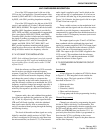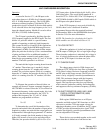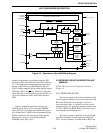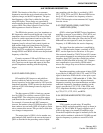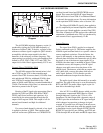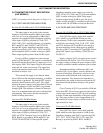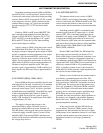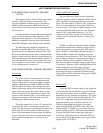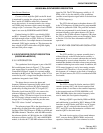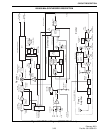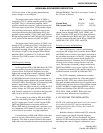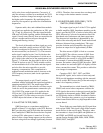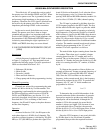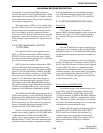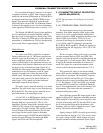
CIRCUIT DESCRIPTION
3-22
February 2001
Part No. 001-9800-001
Over Current Shutdown
Current to final amplifier Q601 on the PA board
is monitored by sensing the voltage drop across R680.
Pins 5 and 6 of U500B are effectively connected
across this resistor. As current increases, the voltage
on U500B, pin 6 decreases which causes the output
voltage on pin 7 to increase. The gain of each U500B
input is set at ten by R509/R504 and R507/R502.
Emitter biasing for Q501 is provided by R506
and R511. Normally, the output voltage of U500B is
not high enough to turn on Q501. However, if current
becomes excessive, for example because of an antenna
mismatch, Q501 begins turning on. This decreases the
base voltage of Q502 which turns off Q500 slightly
and cuts back power output.
3.10 SYNTHESIZER CIRCUIT DESCRIPTION
(800/900 MHz MODELS)
3.10.1 INTRODUCTION
The synthesizer block diagram is part of the RF/
PA board diagram shown in Figure 3-7. The synthe-
sizer output signal is produced by a VCO (Voltage
Controlled Oscillator) located on a separate module
attached to the RF board. The frequency of the VCO is
controlled by a DC voltage from the phase detector in
synthesizer integrated circuit U804.
The phase detector senses the phase and
frequency difference between a highly stable signal
from the reference oscillator (fR) and a frequency
produced by dividing down the VCO signal (fV).
When the signal from the VCO is the same as the
reference frequency, the VCO is on the correct
frequency. If the VCO-derived signal is not the same,
the VCO control voltage increases or decreases to
change the VCO frequency until they are the same.
The VCO is then “locked” on frequency.
The reference input (fR) to the phase detector is
produced by dividing down the signal from reference
oscillator U806. The fR input is 50 kHz for all 800 and
900 MHz channels. Therefore, with 900 MHz models,
the reference divider in U804 divides the 14.850 MHz
reference oscillator signal by 297, and with 800 MHz
models, it divides the 17.500 MHz reference oscillator
signal by 350. The TCXO frequency stability is 1.5
PPM, so this is also the stability of the synthesizer
(and the second injection signal which is derived from
the TCXO frequency).
The VCO-derived input to the phase detector (fV)
is the VCO frequency divided down by programmable
dividers in synthesizer U804. The prescaler and main
divider are programmed for each channel to produce
an input frequency to the phase detector (fV) that is
the same as the 50 kHz reference frequency (fR) when
the VCO is oscillating on the correct frequency. Refer
to Section 3.10.6 for more information on U804
operation.
3.10.2 VOLTAGE-CONTROLLED OSCILLATOR
Introduction
The VCO module is a separate assembly that is
soldered directly to the RF board and covered by a
metal shield. It uses a ceramic substrate that can easily
be damaged by excessive heat; therefore, it is recom-
mended that modules which have been removed using
a standard soldering iron not be reused. In addition, the
VCO center frequency is set by laser tuning ceramic
resonator L907. Therefore, it is not possible to adjust
this frequency if it changes as the result of changing a
part. For these reasons, the VCO is considered not field
serviceable.
Oscillator (Q902)
The VCO is formed by bipolar transistor Q902,
ceramic resonator L907, and several capacitors and
varactor diodes. It oscillates at the transmit frequency
in the transmit mode and 52.950 (800 MHz) or 45
MHz (900 MHz) below the receive frequency in the
receive mode (the first injection frequency).
Biasing of Q902 is provided by R906 and R908,
and stabilization is provided by R912. Inductor L906
functions as an RF choke, and C924 is an AC bypass
capacitor. An AC voltage divider formed by C913,
C917, and C921 starts and maintains oscillation and
matches Q902 to the tank circuit.
The tank circuit consists of laser tuned inductor
L907, varactor diodes CR902-CR904, and several
capacitors. Inductor L907 is laser trimmed to set the
800/900 MHz SYNTHESIZER DESCRIPTION



